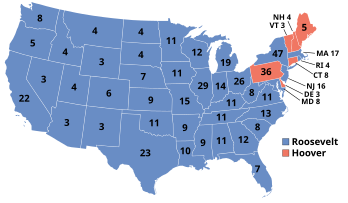1932 United States elections
| ← 1930 1931 1932 1933 1934 → Presidential election year | |
| Election day | November 8 |
|---|---|
| Incumbent president | Herbert Hoover (Republican) |
| Next Congress | 73rd |
| Presidential election | |
| Partisan control | Democratic Gain |
| Popular vote margin | Democratic +17.7% |
| Electoral vote | |
| Franklin D. Roosevelt (D) | 472 |
| Herbert Hoover (R) | 59 |
 | |
| 1932 presidential election results. Red denotes states won by Hoover, blue denotes states won by Roosevelt. Numbers indicate the electoral votes won by each candidate. | |
| Senate elections | |
| Overall control | Democratic Gain |
| Seats contested | 34 of 96 seats (32 Class 3 seats + 5 special elections)[1] |
| Net seat change | Democratic +12 |
 | |
| 1932 Senate results
Democratic gain Democratic hold | |
| House elections | |
| Overall control | Democratic Hold |
| Seats contested | All 435 voting members |
| Net seat change | Democratic +97 |
 | |
| 1932 House of Representatives results
Democratic gain Democratic hold | |
| Gubernatorial elections | |
| Seats contested | 35 |
| Net seat change | Democratic +11 |
 | |
| 1932 gubernatorial election results
Democratic gain Democratic hold | |
The 1932 United States elections was held on November 8, during the Great Depression. The presidential election coincided with U.S. Senate, U.S. House, and gubernatorial elections in several states.[2][3] The election marked the end of the Fourth Party System and the start of the Fifth Party System. The election is widely considered to be a realigning election, and the newly established Democratic New Deal coalition experienced much more success than their predecessors had in the Fourth Party System.[4]
Democratic New York Governor Franklin D. Roosevelt defeated Republican incumbent President Herbert Hoover. Roosevelt won in a landslide, and Hoover only won six Northeastern states. Roosevelt's victory was the first by a Democratic candidate since Woodrow Wilson won re-election in 1916. Roosevelt took his party's nomination on the fourth ballot, defeating 1928 nominee Al Smith and Speaker of the House John Nance Garner.
The Republicans suffered massive defeats in both congressional chambers with many seats switching to Democratic control. Democrats gained ninety-seven seats in the House of Representatives, increasing their majority over the Republicans (and achieving a House supermajority). The Democrats also took control of the Senate, gaining twelve seats from the Republicans.[3] Republicans had controlled the chamber since their electoral success in 1918.[5]
The election took place after the 1930 United States Census and the subsequent Congressional re-apportionment. The Reapportionment Act of 1929 provided a permanent method of apportioning 435 House seats; previously, Congress had had to pass apportionment legislation after each census.
See also
- 1932 United States presidential election
- 1932 United States House of Representatives elections
- 1932 United States Senate elections
- 1932 United States gubernatorial elections
References
- ^ Three Class 3 seats held both a regularly-scheduled election and a special election in 1932. These seats are not double-counted for the total number of seats contested.
- ^ "1932 Presidential Election". The American Presidency Project. Retrieved 29 December 2011.
- ^ a b "Statistics of the Congressional and Presidential Election of November 8, 1932" (PDF). U.S. House of Reps, Office of the Clerk. Retrieved 29 December 2011.
- ^ Reichley, A. James (2000). The Life of the Parties (Paperback ed.). Rowman & Littlefield. pp. 8–12.
- ^ "Party Division in the Senate, 1789-Present". United States Senate. Retrieved 25 June 2014.
